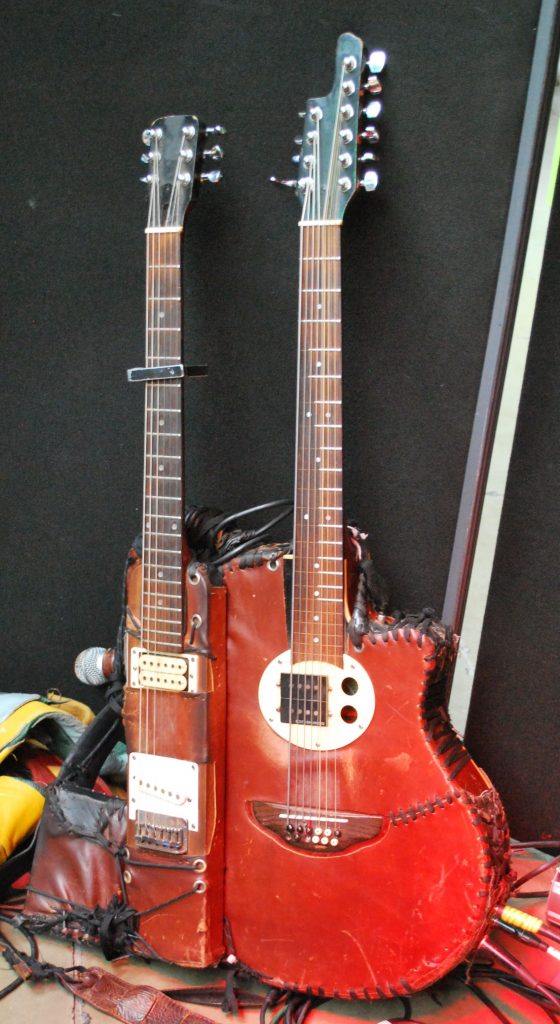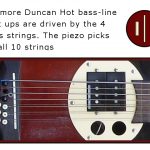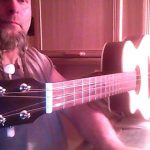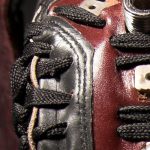Overview
In 2019, I converted my 10 string bass/tres hybrid guitar into a 9 string. During the lockdown of 2020, I extended the ideas in the 9 string into a design circle of 8 guitars called “Mandrake Dynasty”. I authored this page while I was just beginning to work with the ideas that lead to the development of Mandrake Dynasty. It helps chart the progression of the experimentation from where it began with a simple 12 string.
The guitar is a double neck. The top guitar is a normal 6 string electric, The bottom neck is the one with the innovations. It’s a 10 string. I began experimenting with my acoustic 12 string Yamaha APX in 2004. Andy Manners (who had his workshop in the basement of Vintage & Rare Guitars in Bath) did the work for me. I settled on a ten string which was a cross between a partially defretted baritone and half a 12 string. I got legal advice about protecting the intellectual property and decided to disclose (local newspapers and the internet) and use it, rather than trying to take out patents. More recently, I have been exploring the limitations of the original design, by separating out some of the features of the ten string into 6 string guitars (for use in various band collectives), with the intention of eventually revising the design for a custom rebuild.
Read an article about the guitar, published online by “Unfretted”
Design and the creative process
Recent developments: Pushing the design forward
The 10 string placed within a historical context
Joining the two guitars together
Reactions from other musicians
Press disclosure 2006
Joining the two guitars
Recognition From The Guitar Community: Article published online at “Unfretted”
( http://www.unfretted.com/fretless-guitars/partially-fretless-guitars/ ) July 2016
Ash Mandrake 10 String (2006)
It is not often you turn up to a gig and find a Fretless Guitar, even rarer to find a Partial Fretless Guitar.
The Ashmandrake10string is a customised Yamaha APX 12 string. It outranges a normal guitar by one octave. The ratio of the intervals between the strings is standard, but they range from a bass A (7 frets below a bass E on a normal guitar) to a high A (5 frets above the high E on a normal guitar!) The strings are: 4 Bass (flat wound nickel) plus three pairs of strings in octaves (3 bronze wound, and three nickel). The bass strings feed through hot Seymore Duncan, Bass Lines pickups (wired as humbuckers), and the original piezo under the bridge; The 12 string end feeds through the piezo.

Gradually vanishing frets of the Ash Mandrake 10 string with attached 6 string
The guitar is a 16 string that has evolved from the original 10 string and yes, it is covered in leather! The whole assembly includes a vocal microphone which along with the guitar feeds a looper.
Ash Mandrake – the man himself
Ash Mandrake is based in Bath, United Kingdom and is both a performing artist and hat designer. He worked with Andy Manners, of Rare and Vintage Guitars on Bath’s Saville Row, to develop this new guitar. He won a competition to become The Bard of Bath and has played eight times at Glastonbury Festival. Often specific songs will need different hats, he is quite an entertainer with a varied repertoire of comedy, poems and music. I was so impressed I bought three CDs straight off, at times he can sound quite Celtic and has a great voice and vocal range, sometimes so sweet it makes you think of Robert Wyatt.
( http://www.unfretted.com/fretless-guitars/partially-fretless-guitars/ ) July 2016
Design and the creative process
As with many of my creations, the need to overcome a limitation acted as a catalyst. I couldn’t hold down bar chords on my 12 string, so I took the high strings off the lowest three string courses and played it as a nine string (in those days I worried about making changes to tried and tested designs, so I was happy when someone told me Joni Mitchel.had done the same). When it came to the mid noughties, I was enjoying playing low riffs on the bottom three strings of my 9 string, and wanted to get a beefier sound, so I took it lower.
1/ I used different string gagues to make the guitar an A based baritone. I used bronze strings in the bass, tuning it A1 D2 G2 (C3,C4) (E3,E4) (A3,A4)
N.B. There are actually two important re-design features in this change. One is the use of heavier gague strings to give it a baritone range, the other is the use of octave pairs in the highest three string courses (a normal 12 string has pairs in the highest 2 string courses. I don’t think it would be possible to get a string up to E5 with a normal neck length, but tuning down to a baritone means that an octave pair is possible on the highest string course) I used an 8 gague string to achieve this, but it takes an hour to bring the string up to pitch without snapping it.
THE RESULT: The sound from the top three string courses was delightful, and riffs on the lower bass end of the neck were beefier although a little buzzy on the bass A. When strummed, it sounded a bit muddy. I began to realise that I probably wouldn’t be able to strum it and so started focusing riff work on the lower end.
2/ I got Andy Manners to put a bass pick up into the sound hole of the guitar, under the bass strings. He suggested using nickle strings for the bottom three string courses so they would read better through the pick ups. He used cheap pick ups and we tried it.
NB. the bottom three string courses were being picked up both by the bass pickups and the piezo. I bought a little bass amp and guitar amp and started experimenting with this natural cross-over.
THE RESULT: A far beefier bass sound, but with the gagues used (and the corse length of the guitar) a bit muffly and still a bit buzzy through the piezo.
3/ Time to jump off the end of the diving board: I’d got used to the idea of being brave with my only guitar, and decided to take bigger risks. I wanted to see how much I could get out of the neck. I liked the sound of fretless bass, and so decided to go for a defret. I still wanted to play chords at the top of the neck though, because my repertoire required it, and the fact it was my only guitar. I extended that allowance across the neck keeping more frets underneath the higher strings. I had never been able to hold the strings down much above the 15th fret, and so saw this as an opportunity for another experiment. Andy Manners, being an excellent guitarist suggested I keep the 17 fret in, and so all the frets were removed beyond the 17th fret. I wanted to extend the guitar down to a bass E1 and thought there might be room for an extra string course (given that there were only three string at the bass end on a neck intended for paired courses). The bass A was already a bit buzzy through the piazo, so I decided on a high A adjacent to the bass A. We decided to try flatwounds for the four lower courses. I’d been experimenting with acrylic fingernails, and had been picking the top three string courses with my thumb and two fingers. I was picking the C3,C4 string course in a different direction to the E3,E4 and A3,A4 string courses, so I changed the ordering of the two C strings to C4,C3 the three string courses would ring more uniformly. So the tuning then became A1 A2 D2 G2 (C4,C3) (E3,E4) (A3,A4).
N.B. Six new design features were added at this stage of the conversion.
a/ partial defretting,
b/ staggered defretting,
c/ complete defretting beyond fret 17
d/ a seventh string course introduced on a 12 string neck
e/ a non conventional positioning of a high string next to the bass A, breaking the conventional stepped progression in tuning across the neck
f/ switching of the octaves of the third string course (C course).
THE RESULT: At the lower end, new possibilities became possible with double stops and combinations of sliding and non-sliding notes. The top three string courses worked better with my picking style, giving a nice bright sound. I was able to use the octave paired strings above the 17 fret, whereas previously I couldn’t. However, the bass notes were still a bit muffly and the lowest one buzzy through the piazo. It was also difficult to hold down the top three string courses, because of the tension, but also because they were very close together. The sound of the top three string courses was a bit quacky through the piezo, even with pre-amps and reverb.
4/ I started taking the guitar out to open mics, people suggested getting better pickups and a guitar tech suggested using a 90 gague string for the bass A. The new 90 gague solved the buzzing problem through the piezo, but it was a set of hot Seymore Duncan Bass line pick ups which Andy Manners set up as humbuckers brought the lower end to life with the right amps and effects, the guitar became a beast !!
Recent developments: Pushing the design forward
After playing open mics and developing an unusual show, I took my performances out on the road living in vehicles while touring and eventually moving out onto the road permanently. Limited space and issues with power meant there were few opportunities to practice and explore regularly and I used the guitar to make a living, rather than to experiment and explore. More recently, I’ve solved some of the space and power issues and have returned to the design process. Once again, limitations have acted as a catalyst. I produced (with the help of Bary Mairs, Lancashire) a little guitar (“Tres Mandrakus”) which isolates the top three string courses, using a Yamaha T2 travel guitar. It is much easier to play. The strings courses are further apart and the reduced tension on the shorter neck has reduced the quackyness through the piezo.
Here’s a video providing a brief description and demonstration.
And here’s another with the guitar featured in my band collective “Keshanadram”.
The plan is to experiment with design features of the ten string in isolation using a range of guitars which allow the features to breathe. I’ll be using them in band collectives, and taking the pieces I write back into the Ash Mandrake act using the double neck.
The 10 string placed within a historical context
It was interesting to read Jeff Berg’s article in “Unfretted”. I was able to read about partially fretless instruments produced in the early and mid 90s. Partially fretted instruments were very rare. I converged on the notion without knowing the other instruments existed. There are of course partially fretted instruments available commercially now. When I posted a picture of my little three string course guitar on Facebook, somebody compared it to a Cuban tres and I was delighted to watch Cuban Treseiros doing interesting things with their guitars on youtube and to discover I’d had my version of their instrument buried within my doubleneck for a decade. The Cuban tres has been around since at least the end of the 19th century (traditional tunings are G4 G3, C4 C4, E4 E4 and G4 G3, C4 C4, E3 E4 or more recently A4 A3, D4 D4, F#4 F#4 or A4 A3, D4 D4, F#3 F#4) My innovation has been to produce a more jangly and higher sounding instrument . I’ve called my version the “Tres Mandrakus”.
Reactions from other musicians
Here are some of the things that musicians have said
I’ll make no comment:
THE TEN STRING
What’s this? Oh, you’ve done that too … I’m looking forward to hearing it !
I was going to do that.
I’m going to run with your ideas.
THE TRES
Maybe I should get one.
Where did you buy it?
Press Disclosure 2006

Press disclosure of guitar designs 2006
Pioneering guitarist has a new string to his bow
(Published Thurs 19th Oct 2006: Bath Chronicle)
Guitar lover Ash Mandrake is hoping to hit all kinds of new notes with a new instrument.
For more than two years the Bath artist and hat designer has been working with Andy Manners, of Rare and Vintage Guitars on Bath’s Saville Row, to develop his new guitar.
Now it is finally ready, Ash has stuck his neck out and is spreading the word about it through the internet.
“This instrument has completely new sounds because it has a bigger range of pitches,” said Ash.
“it goes higher and lower than other guitars which means you can use a range of techniques.
“It features a loop machine which means you can sample a sound and then play it back and build upon that sound as you play. So it provides a background sound that you can play over and add to as you go.”
The guitar Ash has developed is based on a customised Yamaha APX 12 string that he has turned into a ten string instrument. The spaces between the strings are as on a standard guitar, and it is partially fretless.
The instrument blends the sounds of a bass guitar and a normal guitar. Its lowest string is an octave lower than the deepest note on a standard bass guitar.
“Originally I had a 12 string guitar and wanted to see how far I could take the idea behind it,” said Ash.
“I wanted to see how broad a range of techniques I could use with it.”
Ash, 42 is on the Government’s New Deal for Musicians scheme, which aims to help aspiring song-writers.
Now the design is complete, he has decided to share his unique system with the world instead of patenting the invention. “What I’m working on now is getting some publicity for this creation,” he said.
“So I’m going on the internet to get it in front of people so that if someone does decide to take it up and run with the design and sound, lots of people will know that I created it and there’s a chance I might get some credit for it.
“In the meantime, the guitar community is getting something which it’s not had before. I have taken it out and about to some open mic events in Bath and now I’m starting to get paid gigs to perform with it. I also do some performing and story telling in schools and am showing it off there too.”
Joining The Two Guitars Together
I was using loop machines to build soundscapes and doing this live within the context of my show. Once I’d built soundscapes using the 10string and vocals, I felt the need for a bit of rock guitar lead over the top, and so I talked to Andy Manners about cutting down an electric and joining it onto the 10 string. I’d developed a method of looping seamlessly, without having to pick up and put down instruments, so if I wanted to continue in that vein, I’d need a double neck. Andy made me the strip guitar using materials lying around his workshop, but put a nice set of reconditioned dimarzios on there.
When it came to talking about how to join the two guitars together, i’d run out of money, so I bound them using reclaimed leather and bootlace. It took about 500 hours to achieve it. I locked myself away for nearly a month and came out at the end looking like Cosimodo as I hit the sunlight.
For more details on the guitar visit https://myspace.com/ashmandrake16/












